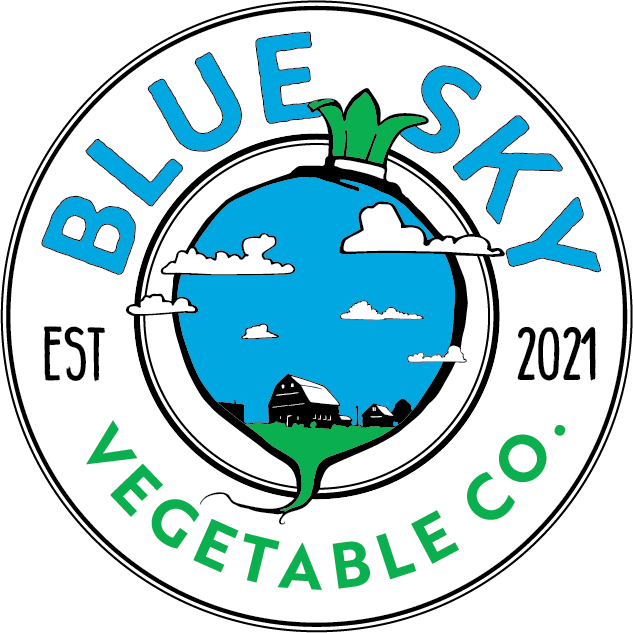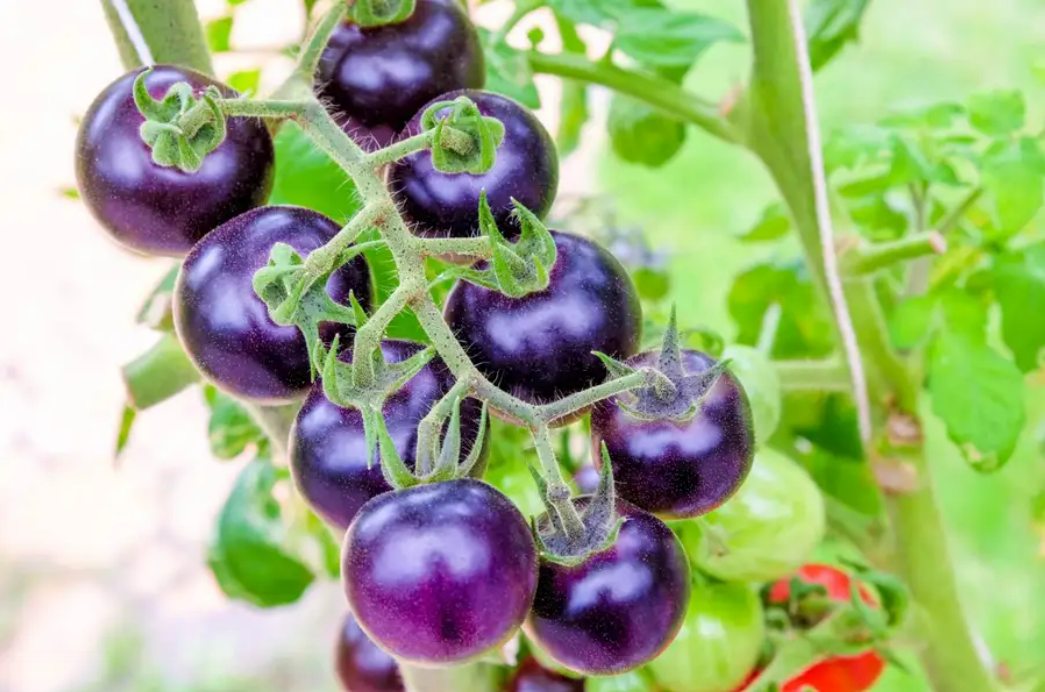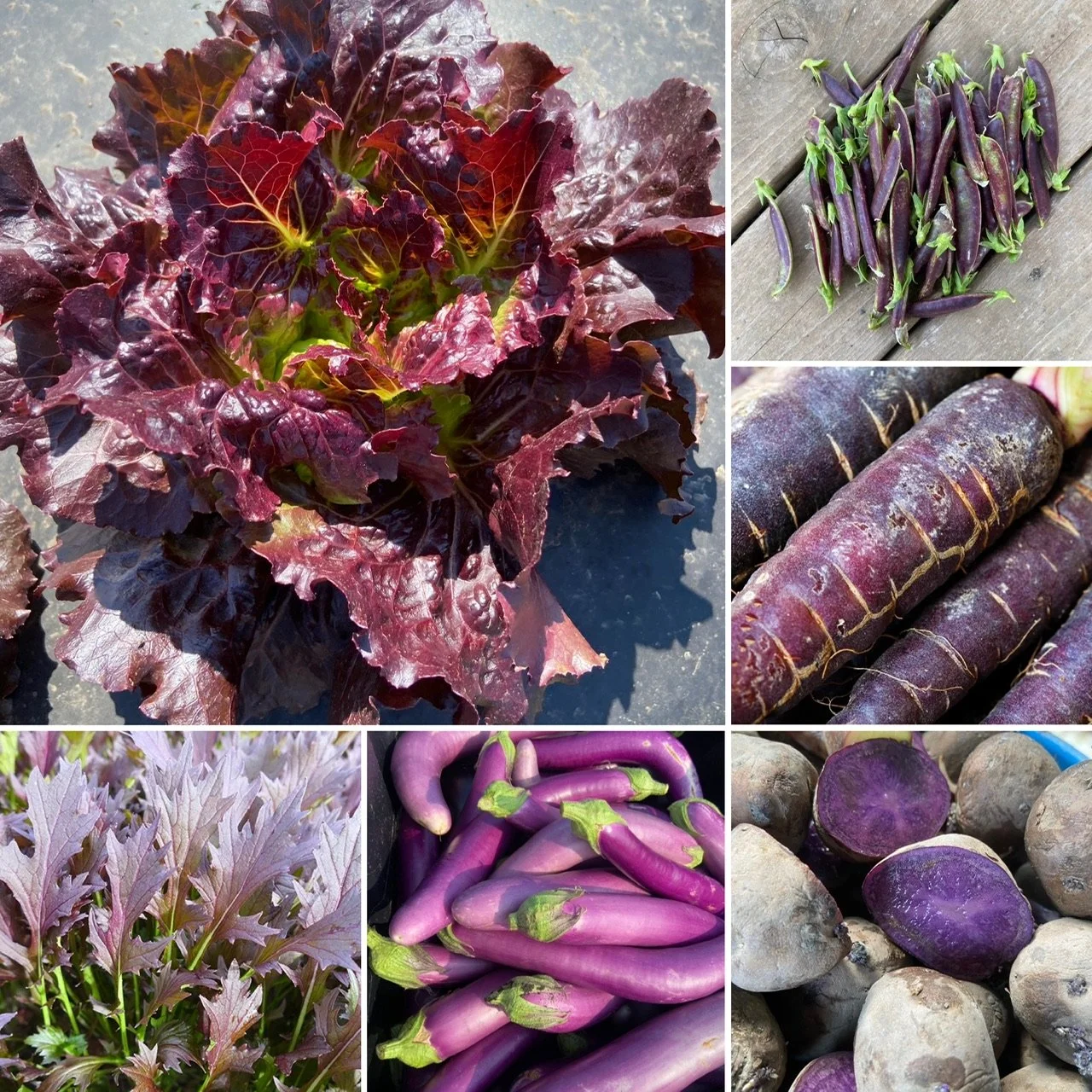Biofortified
A recent food news article caught my eye. It detailed a new variety of tomato that has been genetically modified to an incredible shade of purple and is available for anyone, including home gardeners to buy, grow, and eat. I thought the article was intriguing for several reasons – plant breeding is a fascinating science, genetically modified crops are typically not available for general public use, and I have a “niche interest” in purple vegetables (see more at the end). But what really stood out was the reason behind the genetic modification. The scientists wanted to create a tomato that had more anthocyanins, an antioxidant group that is linked to preventing inflammation, cancer, diabetes and potentially for overall mental health. Anthocyanins are also responsible for deep colors like purple and blue in fruits and vegetables – hence the purple tomato. In order to create this purple tomato, they used a well-used scientific technique to insert a specific gene tied to the purple color in snapdragon flowers into the genetic code of a tomato.
As I read this, I grew a bit frustrated because while I understand this desire – to ensure our food has healthy compounds and plenty of nutrients, I am disappointed at the way it is coming about – through genetic modifications.
The purple tomato itself. Source: https://images.app.goo.gl/i2V8voU7KMun9S3fA
I’ll pause here to say that I have a nuanced view on genetically modified crops, often known as Genetically Modified Organisms or GMOs. I think they need to be considered on a case-by-case basis. For example, 85% of the papaya in the world is now GMO because a devastating virus was destroying papaya trees, and the solution was to insert a gene from the virus itself into the papaya genetic code to confer resistance (kind of like a vaccine). I think this was a case where the use of the technology of genetic modification was a good choice. But that doesn’t mean I think every crop should be genetically modified.
I also can’t be completely against GMOs because I helped to create one in grad school! I was studying a fungus that attacked plant roots and a PhD student in my lab had created a modified version of a similar fungus that glowed in ultraviolet light – it had a gene from a jellyfish that made it "glow" in UV light. He was then able to take UV pictures of the fungus attacking plants to better understand how the fungus attacked the roots. He then walked me through (because the science was still a bit over my head) doing the same with the species of fungus I was working on.
All this to say, I do see some circumstances where genetic modification can be an answer. But not all. Which leads us back to the purple tomato.
Proof that even fungi can "glow up". This picture is from my labmate's publication, he gets all the credit for this neat project, I just followed his protocol. The fungi I worked with were the red ones, his were the green. Source: https://pubmed.ncbi.nlm.nih.gov/31123591/
I think “biofortifying” tomatoes –adding antioxidants or other nutrients through genetic manipulation or modification – is the wrong step because it ignores HOW we grow our food. Biofortification on a genetic level feels reductionist. It seems to say: as long as we can insert the genes that give us the biggest bang for our buck nutritionally, we can all be healthy. But it’s neglecting to look at the broader system.
Can you think back to any science classes in high school? One of the foundational scientific laws is that atoms, such as nitrogen or iron, cannot be lost (think: water cycle or carbon cycle). If there are nutrients in our soil, they may run off in water, be taken up by plants, or convert into different chemical compounds, but nitrogen (and other chemical nutrients) doesn’t just vanish. Because of this scientific law, our food has nutrients because the roots take up nutrients from their growing medium. Food grown in healthy, nutritive soil takes up nutrients from the soil that then pass to us when we eat the food. Studies have shown that plants grown in poor or depleted soil don’t have the same level of nutrients (or this article).
So rather than modifying our food to be “biofortified” genetically, I think our energy and time is better spent on fortifying the living biology of our farm: the soil, microbes, insects, and plants. This means starting with how we take care of the soil. In our farm’s context, it means adding compost, planting cover crops, and ensuring a healthy microbial ecosystem in our soil through different techniques. These steps keep and add more nutrients to the soil, so our vegetables have more nutrients. And honestly, I think it is a better and more holistic solution. We are caring for the soil, microbes, plants, insects, and humans by the way we farm. We are “biofortifying” our food by our stewardship and good farming practices. And we think you can tell by the quality of the food we grow.
Our purple vegetables have nutritional quality because we first care for our soil.
These are all nutritious, vibrant purple vegetables we’ve grown on our farm
On the topic of purple vegetables, I wanted to let you know about a plan for our Farm Share this year. Long before this article, I’ve had a love of purple vegetables – think purple cabbage, or purple beans, or even purple kale! So this year as we made our planting plan, I decided to make a goal of having one week where our Farm Share members can receive all purple vegetables!
My plan is to have this special share (which is included with a normal subscription to any of the sizes of our Farm Shares) be in late August or early September and in the share will (hopefully) be: purple carrots, beets, purple cabbage, purple beans, eggplant, purple mizuna, red onions, purple cauliflower, and purple potatoes.
Just think, instead of a box of green, you get a whole box of purple!



